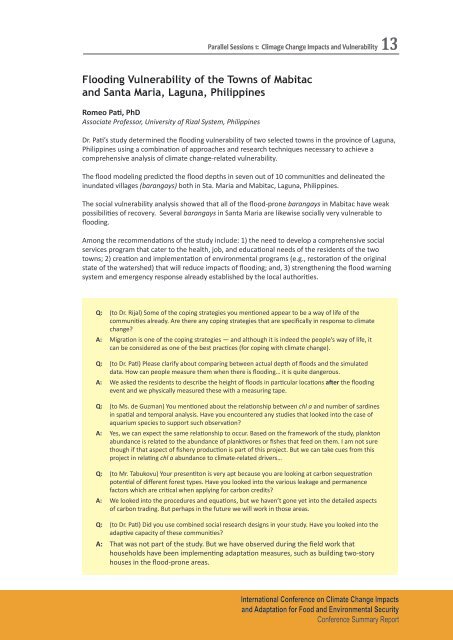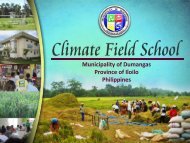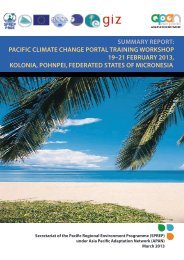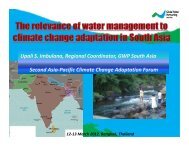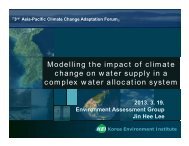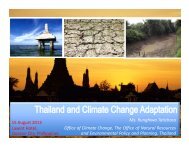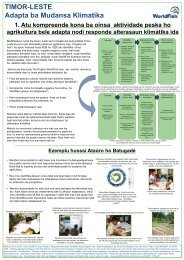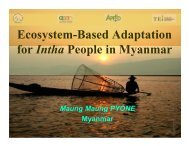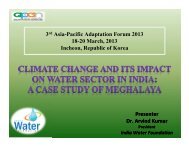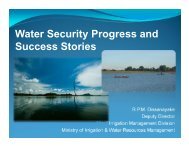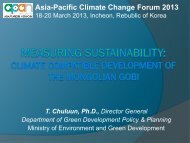PDF file (2.44 MB) - Asia Pacific Adaptation Network
PDF file (2.44 MB) - Asia Pacific Adaptation Network
PDF file (2.44 MB) - Asia Pacific Adaptation Network
You also want an ePaper? Increase the reach of your titles
YUMPU automatically turns print PDFs into web optimized ePapers that Google loves.
Parallel Sessions 1: Climage Change Impacts and Vulnerability13Flooding Vulnerability of the Towns of Mabitacand Santa Maria, Laguna, PhilippinesRomeo Pati, PhDAssociate Professor, University of Rizal System, PhilippinesDr. Pati’s study determined the flooding vulnerability of two selected towns in the province of Laguna,Philippines using a combination of approaches and research techniques necessary to achieve acomprehensive analysis of climate change-related vulnerability.The flood modeling predicted the flood depths in seven out of 10 communities and delineated theinundated villages (barangays) both in Sta. Maria and Mabitac, Laguna, Philippines.The social vulnerability analysis showed that all of the flood-prone barangays in Mabitac have weakpossibilities of recovery. Several barangays in Santa Maria are likewise socially very vulnerable toflooding.Among the recommendations of the study include: 1) the need to develop a comprehensive socialservices program that cater to the health, job, and educational needs of the residents of the twotowns; 2) creation and implementation of environmental programs (e.g., restoration of the originalstate of the watershed) that will reduce impacts of flooding; and, 3) strengthening the flood warningsystem and emergency response already established by the local authorities.Q: (to Dr. Rijal) Some of the coping strategies you mentioned appear to be a way of life of thecommunities already. Are there any coping strategies that are specifically in response to climatechange?A: Migration is one of the coping strategies — and although it is indeed the people’s way of life, itcan be considered as one of the best practices (for coping with climate change).Q: (to Dr. Pati) Please clarify about comparing between actual depth of floods and the simulateddata. How can people measure them when there is flooding… it is quite dangerous.A: We asked the residents to describe the height of floods in particular locations after the floodingevent and we physically measured these with a measuring tape.Q: (to Ms. de Guzman) You mentioned about the relationship between chl a and number of sardinesin spatial and temporal analysis. Have you encountered any studies that looked into the case ofaquarium species to support such observation?A: Yes, we can expect the same relationship to occur. Based on the framework of the study, planktonabundance is related to the abundance of planktivores or fishes that feed on them. I am not surethough if that aspect of fishery production is part of this project. But we can take cues from thisproject in relating chl a abundance to climate-related drivers…Q: (to Mr. Tabukovu) Your presentiton is very apt because you are looking at carbon sequestrationpotential of different forest types. Have you looked into the various leakage and permanencefactors which are critical when applying for carbon credits?A: We looked into the procedures and equations, but we haven’t gone yet into the detailed aspectsof carbon trading. But perhaps in the future we will work in those areas.Q: (to Dr. Pati) Did you use combined social research designs in your study. Have you looked into theadaptive capacity of these communities?A: That was not part of the study. But we have observed during the field work thathouseholds have been implementing adaptation measures, such as building two-storyhouses in the flood-prone areas.International Conference on Climate Change Impactsand <strong>Adaptation</strong> for Food and Environmental SecurityConference Summary Report


